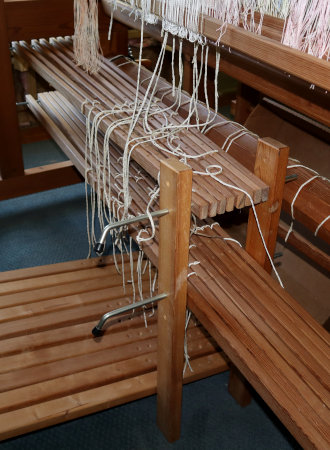A note at the bottom of Mary Meigs Atwater's Cottage Windows pattern states
"Pattern (h) may also be woven in the Italian manner."
This is the variation (pattern h, called "A Modern Arrangement") that I used
for my Cottage Windows table runner. Before I pulled off the waste warp from the loom, I wanted to tie on a
different color warp and give this a try. But first, I needed to research "The
Italian Manner," also referred to as the Italian style or Italian
method.
The simplest definition I found was in Susan Wilson's
Weave Classic Crackle & More. On page 53 she states,
"In the weaving literature, Italian manner or Italian style
refers to polychrome treadling with three colors."
Lucy Brusic is a little more specific. On page 26 of her
A Crackle Weave Companion
she explains,
"Italian Manner in which a repeating thread alternates with the appropriate
opposite blocks."
In examining her treadling chart on the same page, I see that this means that
instead of tabby (using one color for both the 1-3 and 2-4 shots), Italian
manner treadling uses two different colors for the background wefts using
opposite sheds between the pattern shots. For example:
pattern
3-4
pattern
1-2
or
pattern
4-1
pattern
2-3
or
pattern
1-2
pattern
3-4
or
pattern
2-3
pattern
4-1
Compare that to traditional crackle, which is
pattern
1-3
pattern
2-4
In other words, Italian manner replaces tabby with a different set of opposite
sheds.
Other details:
-
Traditional crackle uses one pattern color and one tabby color.
-
Italian manner uses one pattern color and two background colors. The color
sequence remains consistent throughout, it is the treadling that
progresses with each block.
- Pattern treadling is 3-pick straight twill repeats.
- Typically, a heavier pattern weft is used for both.
Harriet Tidball calls the Italian method, "classic crackle" (page 125 of
The Weaver's Book), but on page 54 of Wilson's book, she points out a difference based on
studying historical drafts. What Atwater, Thorpe, Snyder, and Tod call Italian
manner begins the treadling sequence with the pattern weft. Classic crackle
begins the treadling sequence with the background weft. Nit-picky? Perhaps.
It's just interesting to note these differences of observation and
interpretation.
Finally, here are some variations for the Italian manner according to Brusic
(page 27):
- 2-shuttle Italian Manner
- heavier pattern weft in one color
- warp-weight background weft in another color
- treadled as for 3-shuttle Italian manner
- 1-shuttle Italian Manner
- weft similar in weight to warp
- treadled as for 3-shuttle Italian manner
- fabric is said to have a nice drape
I can't say that I've got it all figured out, but I do have a better grasp on
Italian manner weaving than when I started this post.

















